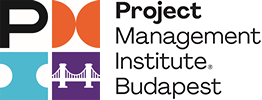January 14 2021 at 05:00AM
Top Ten Trends in PMO for 2021
It’s that time of year again when we take a look into the possibilities and opportunities in the PMO world this year. We’ve been doing these articles for a couple of years and we don’t tend to be too far out. Take last years for example:
Last year’s predictions – obviously made at a time when we had no idea what was going to hit us in March 2020 [full article here]
- BOTS start to become a new member of the PMO team – focused on the mundane, repetitive tasks, it’s not changing our world, just making us think about which processes and work activities can be offloaded.
- A PMO data strategy arrives – following the first steps into project data analytics, we realise that we need decent data and that means having a strategy and a plan.
- More non-project people coming into the PMO role – especially at a senior level to manage the portfolio and enterprise-level PMO functions. The business experience will be key.
- An increase in smaller, boutique-type PMO consultancies in the marketplace – following the IR35 changes within the private sector, the consultancy model will be the way to go.
- As Agile mindsets become more established so will the PMO’s – formalising hybrid methods, processes, approaches, tools and working in the enterprise’s chosen framework.
- Picking off the PMO services, refreshing, energising, stopping, starting – which services you choose to focus on will be driven by your business stakeholders.
- Challenging long-established views and opinions about the PMO – now’s the time to call out the naysayers using your confidence, enthusiasm and passion for PMO. It’s 2020, we’ve changed and we’re not going anywhere.
- One big change – setting objectives and targets for the PMO for the next year and beyond, it needs to include one big hairy audacious challenge to keep everyone motivated and all eyes on the PMO.
- Three years on, the PMO still needs to up their involvement in making change stick – back in 2017 we made the case for the PMO to be more closely aligned in supporting change managers, what are we waiting for?
- Increased confidence leads to increased investments in businesses – leads to increased confidence in the employment and training & development fields, time to switch jobs?
We certainly never knew what was going to hit us in March 2020, and whilst experiments with BOTs might have been shelved for a while; the data agenda perhaps not as crucial right now and we rolled with the punches as far as the employment market was concerned – there have been a few predictions holding up. The agile mindset for one – refreshing services based on the change in working practices, another; some PMOs were definitely able to challenge long-established views about them by providing stellar support during the pandemic. I think we can say we all had one big hairy audacious challenge – forced upon us – as we navigated the new ways of working and collaborating.
So what will 2021 bring? We’ve pulled together our top ten based on all the knowledge being shared from PMO events; PMO Flashmobs, webinars, blogger comment; virtual meetups and little pockets of conversation here and there. Here’s what we have:
PMO Trends for 2021
Here are the new predictions for 2021, what will it have in store for us?
- Portfolio prioritisation and optimisation really helped organisations pivot and change priorities quickly in 2020, now is the time to optimise the process.
- Our world went virtual and dispersed, this year we will consolidate the learnings and improve on how we engage and work with people remotely.
- With the launch of the new PMO Competency Framework, understanding where the skills gaps are and the learning & development required to plug the gaps will get easier.
- The rise of the PMO Wellbeing Office, not just for pandemics, the PMO is in a prime position to support the health and wellbeing of change colleagues with signposting services.
- Agile, Lean, DevOps, product management – bimodal, hybrid delivery, whatever we’re calling it, the PMO is supporting more of it. Education, experience, lessons to be learnt in the successful supporting of them all.
- Maturity in the data visualisation aspects of project reporting – we want to build the case for more AI-led technologies in project management but will settle for improving the way data converts to information, insights and action.
- Time to take stock and get back to basics – the need to optimise new ways of working and adapt existing for the hybrid office / remote working environment.
- Perfecting the art-of-the-gathering, advanced techniques and approaches for making the most out of precious face-to-face time.
- Adoption of PMO metrics and measures which help focus on the right things – using OKRs.
- Being at the front of the room, time for the PMO to up their game when it comes to public speaking; communicating to senior executives; facilitating sessions and being visible.
Let’s take a look at those and find out more about them:
One:
Portfolio prioritisation and optimisation really helped organisations pivot and change priorities quickly in 2020, now is the time to optimise the process.
If there was one thing that made the PMO shine during the pandemic – it was the ability to support the business with the right information at the right time which enables optimal decision-making when it was most needed.
The word ‘pivot’ became the word of the day as organisations went from business-as-usual change to survival mode change. Without having good portfolio management in place, organisations found it difficult to know which projects to can; which to put on ice; which to direct key resources to. Now was the right time for the PMO to shine, roll its sleeves up and show exactly why we need portfolio management in our change organisations.
As we look forward, we’re in an ideal place to build on that, learn from the lessons and think about how this whole process can be further optimised for the better.
PMO Flashmob: the session we did at #PMOwfh back in May with Adam Skinner is a great session to catch up on – From Crisis to Recovery: What the PMO Can Be Doing Now
Two:
Our world went virtual and dispersed, this year we will consolidate the learnings and improve on how we engage and work with people remotely.
Cast your minds back to March when suddenly Teams, Zoom, Webex became both the saviours and our taskmaster for keeping the show on the road and being able to work remotely. A blessing and a curse, we all got to grips with the whole camera on or off; mic on mute; and awkward silences.
It was the PMO’s job to keep in touch as a team; keep motivation and performance high; keep the wheels of projects turning. For some of you, you became the gurus – supporting delivery teams throughout. Some became a place of social exchange, creating virtual coffee points. We embraced different tools to support polling, whiteboarding, collaborative report writing, Kanban boards and facilitated lessons learnt and retrospectives.
We continue to learn how to get better at it – it’s a new skill, communicating and getting work done when it’s virtual and dispersed. You should really have your own retrospective on how the PMO can get better at it next year and beyond.
PMO Flashmob: throughout the first lockdown with #PMOwfh we experimented and played together with all the tools available to see what would work back in the job. We’ll continue doing that and invite you to carry on playing and experimenting with us.
Three:
With the launch of the new PMO Competency Framework, understanding where the skills gaps are and the learning & development required to plug the gaps will get easier.
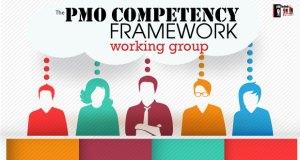 Finally, after three years of hard work by the PMO community, we have the launch of the PMO Competency Framework in February 2021. There’s no doubt that a competency framework can really help a professional in their work and in their career.
Finally, after three years of hard work by the PMO community, we have the launch of the PMO Competency Framework in February 2021. There’s no doubt that a competency framework can really help a professional in their work and in their career.
The PMO Competency Framework is a career tool that not only allows you to assess yourself against existing PMO role profiles, it is also a great tool for understanding what’s possible in a PMO career and which areas to concentrate on to increase your competency.
With a tool like this, we have common ground – for those just entering the profession, understanding what is expected of them, right through to experienced Analysts, Managers and Directors. We never stop learning, in fact, for any PMO professional you know that your learning stops when your organisation stops evolving and changing. Now we have something which helps guide that learning.
PMO Flashmob: expect to see the launch event in February 2021.
Four:
The rise of the PMO Wellbeing Office, not just for pandemics, the PMO is in a prime position to support the health and wellbeing of change colleagues with signposting services.
Whilst the “PMO is not involved (nor should it) with serious health and well-being issues but the PMO is becoming more mindful and better able to recognise these issues, signpost support and flag organisational issues due to their reach across the organisation.” We heard about one organisation’s PMO and their services and support in this area during a #PMOwfh session and what became quickly apparent is that the PMO is in a prime position to spot the changes in people delivery projects.
We can help but we need to understand more about how we can do that, we’re not professional coaches or counsellors but ultimately we do care about projects and their people.
PMO Flashmob: take a look at a couple of sessions we held which focus on the wellbeing role of the PMO – Emerging from Lockdown – Health and Wellbeing from the PMO and The Wellbeing Journey
Five:
Agile, Lean, DevOps, product management – bimodal, hybrid delivery, whatever we’re calling it, the PMO is supporting more of it. Education, experience, lessons to be learnt in the successful supporting of them all.
We’ve been covering Agile approaches for years, now Agile-at-Scale, then Dev Ops, continuous delivery and product management. There’s certainly more delivery approaches than we’ve ever had to know about and no doubt there will be plenty more to come. More education, being curious to learn, sharing our experiences is key and lessons definitely have to be learnt.
We continue to understand how the organisation – using a myriad of different delivery approaches – can be supported and it’s up to the PMO to learn how it monitors and reports on progress across all the different projects regardless of delivery approach. There are different parts of the puzzle to work out, either different jigsaw sets to acquire. We’re on a continuous learning adventure.
PMO Flashmob: recent sessions on SAFe and DevOps can be checked out.
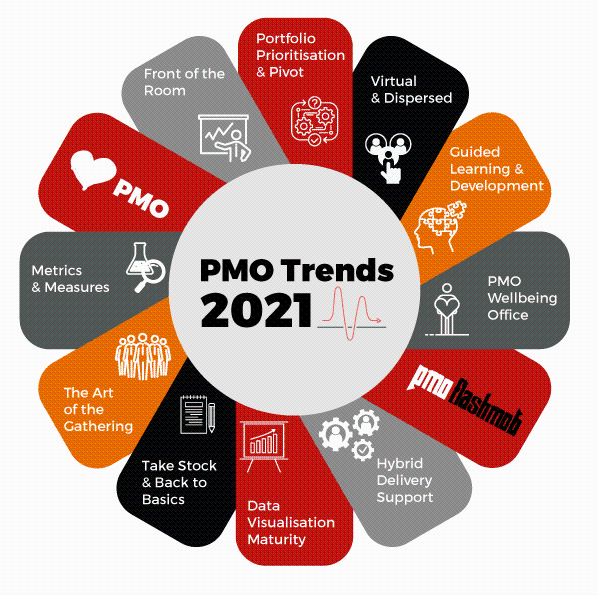
Six:
Maturity in the data visualisation aspects of project reporting – we want to build the case for more AI-led technologies in project management but will settle for improving the way data converts to information, insights and action.
Maturing the quality of data that the PMO handles is a long and difficult road that requires organisational backing and the funding to really make it work. Whilst the whole field of data analytics continues to champion the advancement of project data management plans and investment in data analysts, the PMO has been happy to work with what its got and transform current project data to eye-catching visuals and narratives.
With so many organisations having access to Office 365, PowerBI became the tool of choice for having a play about with what might be possible – we thought out how creative we were, and where perhaps more creativity might be required. PMOs have been building up their confidence to test out business storytelling, paring eye-popping visuals with compelling narratives that provide the insights to aid decision-making.
If you’re in any doubt about how popular data visualisations are – just drop one of yours in the PMO Flashmob Linkedin group and see how many PMO professionals you get pouring over your latest efforts!
PMO Flashmob: we started off 2020 with the Inside PMO Report – Artificial Intelligence: Threat or Opportunity for the PMO.
Seven:
Time to take stock and get back to basics – the need to optimise new ways of working and adapt existing for the hybrid office / remote working environment.
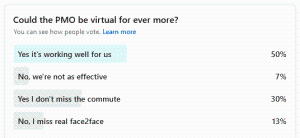 We recently asked the PMO Flashmob crowd about the kind of things they’d like to see covered at PMO Flashmob and a ‘back to basics’ option seemed to prove very popular. And we say why not?
We recently asked the PMO Flashmob crowd about the kind of things they’d like to see covered at PMO Flashmob and a ‘back to basics’ option seemed to prove very popular. And we say why not?
Even if we think we all know the basics – how to plan; how to run a risk workshop; how to file stuff – in lots of ways these basics have already become something else as we started working from home and generally becoming more virtual as a PMO. As we look to the future, we perhaps will never be all in the office at the same time, or indeed all at home at the same time. It’ll be a combination of the two, so how will this affect the basic services offered?
Time to dust off the service catalogue and look at it with a fresh pair of eyes, or at least with your hybrid working hat on (sounds funky!)
PMO Flashmob: join us for events throughout the year where no matter what we’re discussing we know we’ll be talking about how we adapt it to the situations we find ourselves in.
Eight:
Perfecting the art-of-the-gathering, advanced techniques and approaches for making the most out of precious face-to-face time.
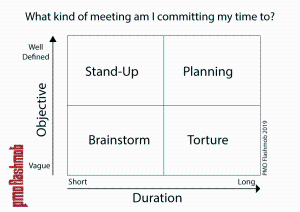
“A rethink around meeting culture could be on the cards too. As people adapt to hybrid working where they are only in the office for a small percentage of their week, face-to-face meetings will become a more valuable commodity than ever. There will be increased pressure on organizers to put in the groundwork and demonstrate excellent facilitation skills to extract every ounce of value out of these sessions.”
Speak to any great facilitator and it’s all about learning, practising and having great tools and techniques at your fingertips. The art is in the planning and there are plenty of different approaches to use to suit your gathering. When we add in the virtual and hybrid situation, we need to think differently about how we engage; get people to contribute; drive out the insights and take action.
PMO Flashmob: we’ve had facilitation sessions before at PMO Flashmob, now’s the time to revisit for modern times. The PMO as a Facilitator is one resource to take a look at.
Nine:
Adoption of PMO metrics and measures which help focus on the right things – using OKRs.
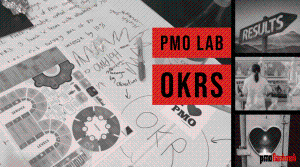 Mention PMO measures and metrics and most PMO professionals ears will prick up; we all like to know how we’re measuring up to objectives and expectations – we even did a whole report around it a couple of years ago – PMO KPIs, Metrics and Measures.
Mention PMO measures and metrics and most PMO professionals ears will prick up; we all like to know how we’re measuring up to objectives and expectations – we even did a whole report around it a couple of years ago – PMO KPIs, Metrics and Measures.
One approach which we’ve seen working well for PMO teams is using OKRs – Objectives and Key Results. You can check out one of the sessions that covered it. The PMO is adopting it as a way to help develop the PMO itself, it’s a simple and effective tool which can be tracked throughout the year.
“The whole idea of using OKRs was about goal setting for the PMO – in other words, using it on the PMO itself, so the PMO Manager and the team are all involved in setting it up.”
We like the idea of the whole team setting their own OKRs – and we’re seeing how others are using it to great effect too.
PMO Flashmob: watch out for the session we do in 2021 where we’ll share the different types of OKRs that are working for PMOs.
Ten:
Being at the front of the room, time for the PMO to up their game when it comes to public speaking; communicating to senior executives; facilitating sessions and being visible.
With all the sessions we’ve done over the years, one of the major things that holds the PMO back is the lack of confidence in public speaking; or getting up there, upfront and leading sessions in front of all manner of colleagues and managers. It’s a topic area we come back to time and time again. When we’re discussing what stakeholders want from the PMO, it’s the ability to confidently hold those conversations. When we’re expected to be open to challenge and debate; provide candid feedback and recommendations; build relationships; to persuade and influence.
All of these require us to be comfortable being visible and vocal. It takes time to build confidence, but confidence comes from knowing what you’re talking about – and sometimes having a leap of faith and just doing it.
Time to overcome the uncomfortable and see where it takes you in your career next year.
That’s our trends predictions for 2021, how about you? Any missing? What would you add?
Source: Lindsay Scott, Top Ten Trends in PMO for 2021, pmoflashmob, 2020 December
https://pmoflashmob.org/top-ten-trends-in-pmo-for-2021/
